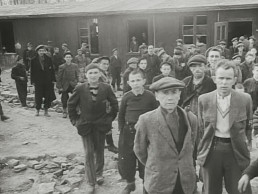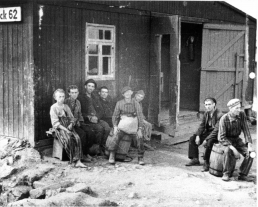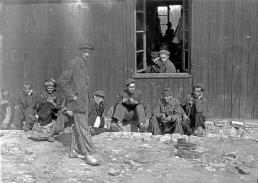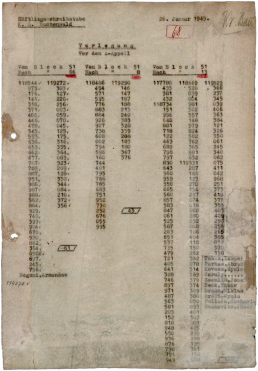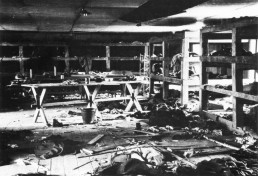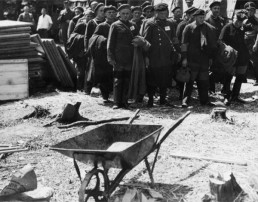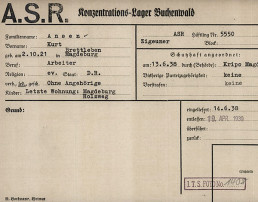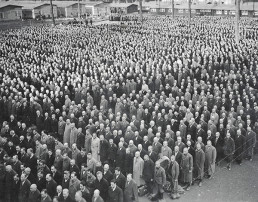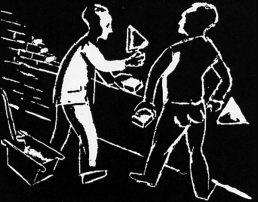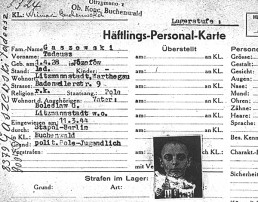Limited shelter: The children’s blocks 8 and 66
Children were particularly vulnerable to the dangers of the camp. To protect them, political prisoner functionaries set up a children’s block in Block 8 of the main camp in July 1943. In the Little Camp, Barracks 66 served as a children’s block from January 1945 onwards.
Most of the children in these blocks were between 14 and 17 years old. They did not have to work, but they received only half of the already meager food rations. Hunger was omnipresent, but until mid-1944 it was possible to organize secret classes and small cultural events.
Despite all the efforts of the political prisoner functionaries to prevent it, the SS repeatedly sent children on extermination transports to Auschwitz and other death camps. On 10 April 1945, the SS entered the Little Camp and dispatched many minors on death marches. When the camp was liberated on the next day, there were 900 children and adolescents still alive. At least 1600 had died.
"[...] as we stood outside at roll call in the biting cold and deep snow, the block elder informed us that all children up to the age of 16 should report to him for transfer to a children's block. After a short break, panic suddenly broke out. We all suspected a ruse. The children had seen enough, everyone thought it was a trick to finish us off [...]. Of course, most of them reported for transport right away, for almost all of them it was a fateful decision. Very few of them survived. After my experiences in Buchenwald, I had the feeling that the block elder could be trusted."
Report by Robert J. Büchler, 1994.
Robert J. Büchler (1929-2009) was persecuted as a Jew, and the SS deported him from Auschwitz to Buchenwald in January 1945 at the age of 16. Fellow prisoners housed him in the Children’s Block 66 of the Little Camp. One day before liberation, the SS sent him on a death march from which he was able to flee.
(Robert J. Büchler, “Am Ende des Weges. Kinderblock 66 im Konzentrationslager Buchenwald,” in: Dachauer Hefte 6, 1994).
Antonín Kalina (front right) in front of Block 66 in the Little Camp, after 11 April 1945.
Beginning in late 1944, the Czech Communist Antonín Kalina (1902-1990) was the block elder responsible for the children and teenagers in Block 66. He used his contacts with the camp resistance and changed the names of Jewish children in early April 1945 to protect them from the death marches. Public recognition for the man deported to Buchenwald in 1939 did not come until after his death. In 2012, he was honored by the Yad Vashem memorial as a Righteous Among the Nations.
(Buchenwald Memorial)
Liberated teenagers sitting in front of Block 62 in the Little Camp, between 11 and 15 April 1945.
In 1944/45, the Little Camp, where conditions were even worse than in the main camp, housed a particularly large number of children and teenagers. They had come to Buchenwald with transports from the evacuated camps in the east, including Auschwitz.
(Buchenwald Memorial)
Liberated teenagers in front of Children’s Block 66, after 11 April 1945.
Children’s Block 66, which was built by prisoner functionaries, saved many children and adolescents from deportation to forced labor in subcamps and certain death. In the children’s block, the young people were also better protected from being assaulted by fellow adult prisoners.
(Buchenwald Memorial)
Abandoned housing in Children’s Block 66 of the Little Camp, April/May 1945.
The primitive three-level wooden platforms used as beds were typical for the wooden barracks in the Little Camp. Shortly before liberation, the SS drove many prisoners on death marches. The barracks were searched and destroyed when they searched for Jewish prisoners.
(Photo: Alfred Stüber, Buchenwald Memorial)
Children in the Buchenwald Concentration Camp
Aktion Arbeitsscheu Reich 1938
In 1938, the number of prisoners in the concentration camps doubled. As part of the Aktion Arbeitsscheu Reich (Operation Work-Shy Reich, two waves of arrests of purported “anti-social…
1938: Deported to Buchenwald as “special operation Jews”
In the course of the November pogroms of 1938, the Gestapo sent 30,000 Jews, designated by the SS as “special operation Jews,” to concentration camps.
Rescue Initiatives: Bricklayers’ school and Poles’ school
Under the pretext of training skilled workers for the German war effort, prisoner functionaries around Robert Siewert, a political prisoner and Kapo of the construction detail
Deterrence through forced labor: Disciplinary work prisoners
From 1941 to 1944, a Gestapo labor re-education camp existed at the Buchenwald Concentration Camp.
